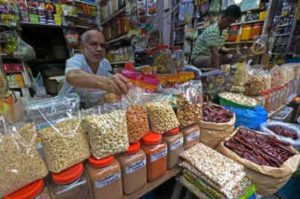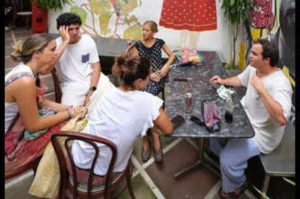Foreign Para in New Market: On a humid evening in Kolkata, the air around Lindsay Street is thick with the aromas of sizzling shawarmas, steaming momos, and roasted Ethiopian coffee. Just a few steps away from the iconic Gothic arches of New Market, a different Kolkata begins—one that is not bound by borders or passports. This small but vibrant pocket is known as Foreign Para, a term that locals lovingly use to describe the concentration of eateries and shops run by foreign nationals.

Foreign Para has, over the years, grown into a melting pot of global flavors and cultures. What might seem like a narrow lane of restaurants is, in reality, a microcosm of international migration, adaptation, and belonging. From Middle Eastern students to African traders and East Asian families, this neighborhood reflects Kolkata’s longstanding openness to the world.
A Historical Backdrop: From Colonial Trade to Global Cuisine


Kolkata, formerly Calcutta, has always been a gateway city. During the British colonial era, it was the capital of India and a thriving hub for trade. New Market, established in 1874, was originally meant for the British elite, who wanted a clean and exclusive shopping destination away from the chaos of Indian bazaars. Over the decades, it transformed into a cosmopolitan trading hub, drawing merchants from China, Armenia, Baghdadi Jews, and Anglo-Indians.
The legacy of this international exchange has continued. Today, the same market that once catered to British high society now houses Syrian bakers, Nigerian food stalls, Nepalese momo vendors, and Afghan kebab joints. Foreign Para is, in many ways, the modern evolution of Kolkata’s trading spirit.
The People Behind Foreign Para


Middle Eastern Families
Walk into one of the shawarma stalls, and you might meet Abdul Rahman, a Syrian who arrived in Kolkata a decade ago as a student. Missing the taste of home, he began cooking for friends. What started as small home gatherings slowly grew into a business. Today, Rahman’s restaurant is packed every evening with both foreigners and Kolkatans queuing up for kebabs, falafel wraps, and cardamom-scented tea.
African Students and Entrepreneurs
Kolkata has a large number of students from Nigeria, Ghana, Ethiopia, and Sudan, drawn by the city’s universities and affordable medical education. Many of them found that Kolkata lacked authentic African food, and thus small eateries cropped up. These restaurants serve jollof rice, grilled tilapia, spicy goat curry, and injera bread, often with Afrobeat music playing in the background.
For African students, these eateries are not just dining spaces but community centers, places where they can speak in their native languages, watch football matches, and celebrate festivals away from home.
East & Southeast Asian Influence
The Chinese community in Kolkata has a long history, with Tangra once being the city’s “Chinatown.” Though much smaller today, their influence lives on in Foreign Para, where dumplings, noodles, and soups are a daily staple. Alongside them, Nepalese and Bhutanese eateries have introduced momos, thukpa, and yak-cheese delicacies, which have quickly been adopted into Kolkata’s mainstream food culture.
Foreign Para in New Market: Food as the Universal Language
Food is the lifeline of Foreign Para. Every corner offers an international culinary experience:
- Middle Eastern Cuisine: Shawarma, hummus, baklava, kebabs.
- African Specialties: Jollof rice, fufu, grilled meats, pepper soup.
- East Asian Dishes: Dumplings, fried noodles, bao, kimchi.
- South Asian Crossovers: Afghan pulao, Nepali thukpa, Bhutanese ema datshi.
What makes Foreign Para stand out is affordability. Unlike luxury international restaurants in five-star hotels, these eateries are pocket-friendly. A filling African meal costs less than ₹300, while a plate of shawarma or dumplings is around ₹100–150. This accessibility has turned Foreign Para into a democratic global dining zone for students, working professionals, and tourists alike.
A Second Home for International Students
Kolkata is home to thousands of international students enrolled in Jadavpur University, Calcutta University, Presidency University, and private medical colleges. While academics bring them here, many struggle with homesickness. Foreign Para has emerged as their lifeline.
Take the story of Aisha, a Nigerian medical student, who visits the Para every weekend. “When I eat jollof rice here, I feel like I’m back in Lagos,” she says. Similarly, Ahmed from Afghanistan explains that the kebabs and pulao remind him of Kabul evenings with family.
Foreign Para, thus, plays a psychological and emotional role. It provides comfort, familiarity, and a sense of belonging in an otherwise foreign land.
Locals Discover the World on a Plate
Interestingly, Foreign Para is no longer just a migrant community’s hub. Kolkatans themselves have embraced it. Food vloggers document its hidden gems, office-goers stop by after work, and families explore it on weekends.
For many young Kolkatans, eating here is their first introduction to African or Middle Eastern food. College students particularly love the Para because it allows them to experiment with global tastes at affordable rates.
Instagram reels featuring shawarma rolling, momo steaming, and injera being flipped on hot pans have made Foreign Para a social media sensation.
Challenges of Foreign Para
Despite its popularity, the community faces hurdles:
- Licensing & Regulation: Many eateries struggle with obtaining formal licenses, leaving them vulnerable to sudden crackdowns.
- Language Barriers: Communication between foreign vendors and Bengali-speaking locals often leads to confusion.
- Stereotyping: Migrants, especially Africans, sometimes face prejudice or misunderstanding.
- Economic Pressure: The COVID-19 lockdowns nearly wiped out footfall, pushing many small businesses into debt.
Yet, despite these obstacles, the resilience of the community has kept the area alive.
Cultural Exchange Beyond Food
Foreign Para is not just about dining—it is also about cultural immersion. Visitors often find themselves listening to Arabic music, Afrobeat rhythms, or even K-pop blasting from speakers. Shops sell African fabrics, Middle Eastern perfumes, and East Asian snacks, making it a miniature global market.
During football tournaments, especially the FIFA World Cup, the Para becomes a carnival. Foreign students paint flags on their cheeks, cheer for their teams, and turn the lanes into an open-air stadium. Local Kolkatans often join in, creating a rare bond across cultures.
Symbol of Kolkata’s Cosmopolitan Soul
Kolkata has always prided itself on being a city of ideas, debates, and inclusivity. From Durga Puja pandals inspired by world architecture to neighborhoods where churches, mosques, temples, and synagogues stand side by side, Kolkata thrives on diversity.
Foreign Para adds another layer to this identity. It is proof that the city doesn’t just tolerate difference—it celebrates it, absorbs it, and makes it its own. Just as the Anglo-Indians shaped Park Street and the Chinese community built Tangra, today’s foreign migrants are reshaping New Market.
The Road Ahead: Potential and Preservation
With Kolkata positioning itself as a hub for education, medical tourism, and cultural exchange, the role of Foreign Para is bound to grow. However, for it to thrive, city planners and civic authorities must consider:
- Providing better infrastructure and hygiene facilities.
- Easing legal hurdles for migrant entrepreneurs.
- Organizing food and cultural festivals to promote it as a tourism hotspot.
- Preserving its authenticity while ensuring safety and regulation.
If nurtured well, Foreign Para could emerge as India’s answer to global neighborhoods like London’s Brick Lane or New York’s Chinatown.
Conclusion: A Global Village Within a City
Foreign Para is not just a lane in New Market—it is a story of migration, resilience, adaptation, and community. It shows how Kolkata, despite its colonial past and modern challenges, continues to be a city that embraces the world.
As one walks through its bustling lanes—past the shawarma stands, dumpling counters, and jollof rice pots—it becomes clear: Kolkata’s heart beats not just in Bengali, but in many languages, many flavors, and many cultures.
External References for Readers
- History of New Market, Kolkata
- Kolkata’s Culinary Diversity
- Cultural Mix in Kolkata
- Study in Kolkata: Guide for International Students
Also read: Home | Channel 6 Network – Latest News, Breaking Updates: Politics, Business, Tech & More

